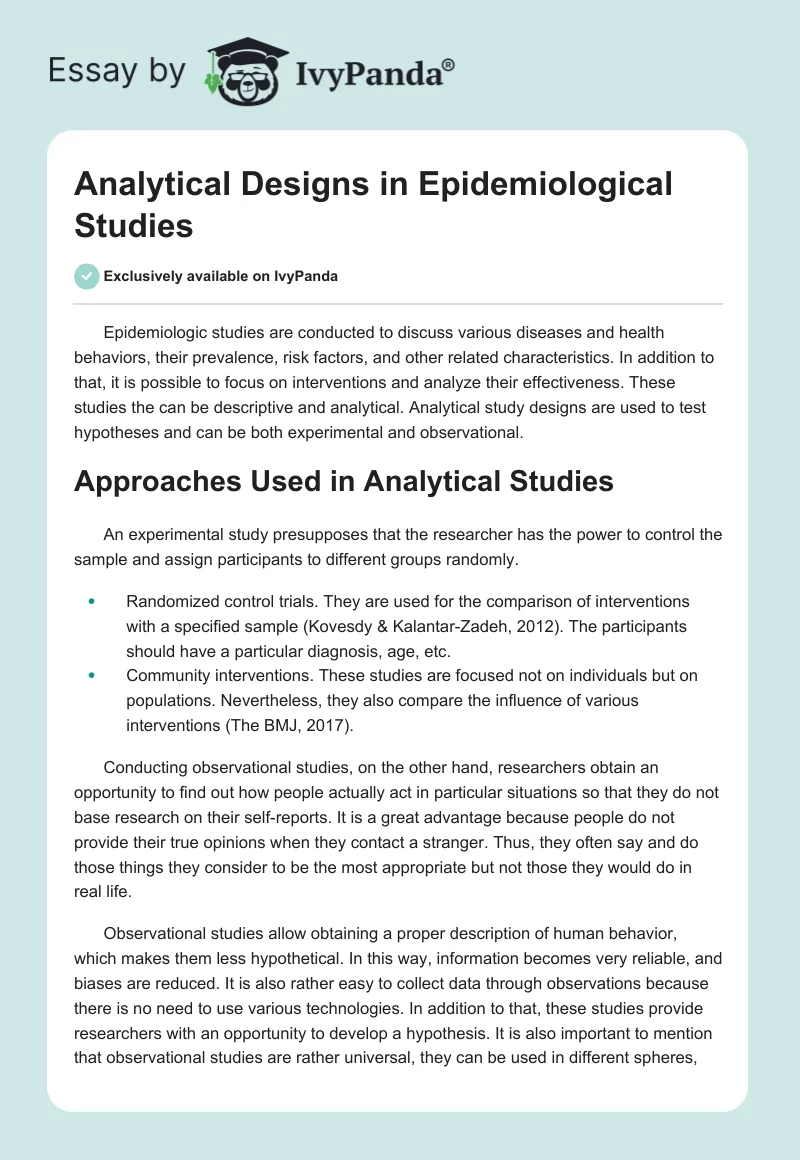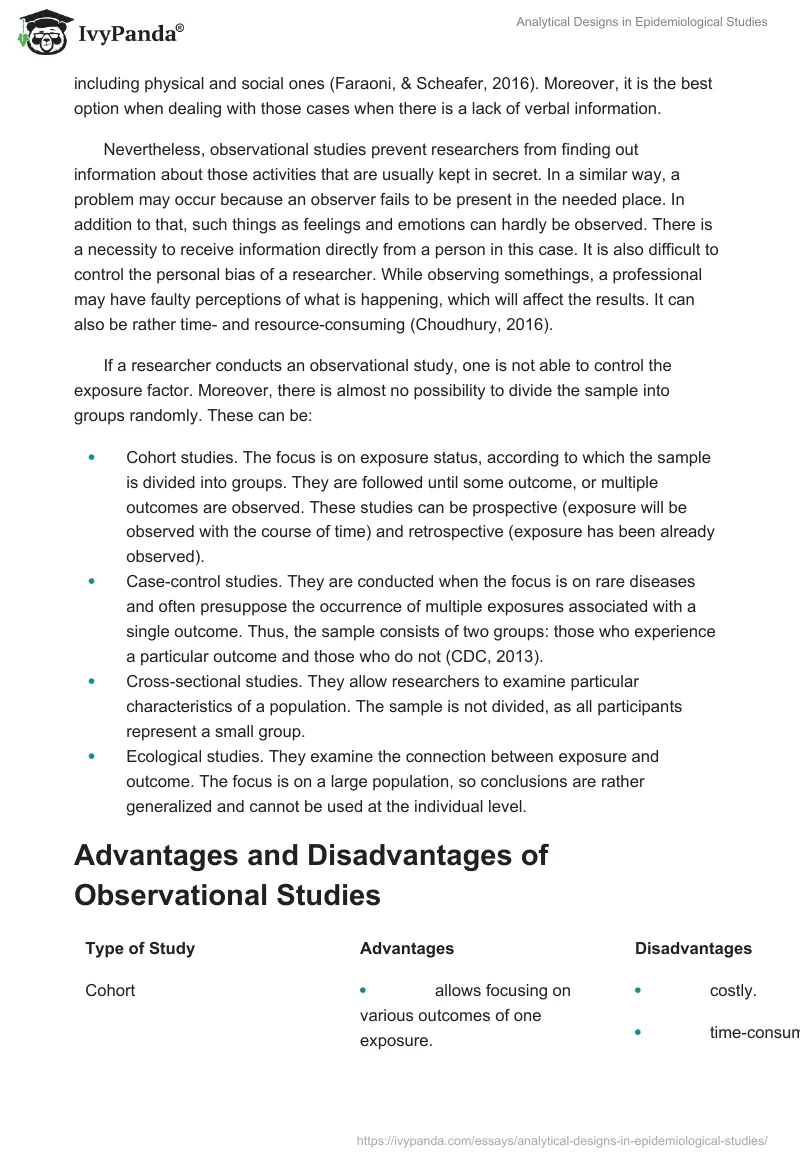Epidemiologic studies are conducted to discuss various diseases and health behaviors, their prevalence, risk factors, and other related characteristics. In addition to that, it is possible to focus on interventions and analyze their effectiveness. These studies the can be descriptive and analytical. Analytical study designs are used to test hypotheses and can be both experimental and observational.
Approaches Used in Analytical Studies
An experimental study presupposes that the researcher has the power to control the sample and assign participants to different groups randomly.
- Randomized control trials. They are used for the comparison of interventions with a specified sample (Kovesdy & Kalantar-Zadeh, 2012). The participants should have a particular diagnosis, age, etc.
- Community interventions. These studies are focused not on individuals but on populations. Nevertheless, they also compare the influence of various interventions (The BMJ, 2017).
Conducting observational studies, on the other hand, researchers obtain an opportunity to find out how people actually act in particular situations so that they do not base research on their self-reports. It is a great advantage because people do not provide their true opinions when they contact a stranger. Thus, they often say and do those things they consider to be the most appropriate but not those they would do in real life.
Observational studies allow obtaining a proper description of human behavior, which makes them less hypothetical. In this way, information becomes very reliable, and biases are reduced. It is also rather easy to collect data through observations because there is no need to use various technologies. In addition to that, these studies provide researchers with an opportunity to develop a hypothesis. It is also important to mention that observational studies are rather universal, they can be used in different spheres, including physical and social ones (Faraoni, & Scheafer, 2016). Moreover, it is the best option when dealing with those cases when there is a lack of verbal information.
Nevertheless, observational studies prevent researchers from finding out information about those activities that are usually kept in secret. In a similar way, a problem may occur because an observer fails to be present in the needed place. In addition to that, such things as feelings and emotions can hardly be observed. There is a necessity to receive information directly from a person in this case. It is also difficult to control the personal bias of a researcher. While observing somethings, a professional may have faulty perceptions of what is happening, which will affect the results. It can also be rather time- and resource-consuming (Choudhury, 2016).
If a researcher conducts an observational study, one is not able to control the exposure factor. Moreover, there is almost no possibility to divide the sample into groups randomly. These can be:
- Cohort studies. The focus is on exposure status, according to which the sample is divided into groups. They are followed until some outcome, or multiple outcomes are observed. These studies can be prospective (exposure will be observed with the course of time) and retrospective (exposure has been already observed).
- Case-control studies. They are conducted when the focus is on rare diseases and often presuppose the occurrence of multiple exposures associated with a single outcome. Thus, the sample consists of two groups: those who experience a particular outcome and those who do not (CDC, 2013).
- Cross-sectional studies. They allow researchers to examine particular characteristics of a population. The sample is not divided, as all participants represent a small group.
- Ecological studies. They examine the connection between exposure and outcome. The focus is on a large population, so conclusions are rather generalized and cannot be used at the individual level.
Advantages and Disadvantages of Observational Studies
Circumstances that Merit the Use of the Observational Studies
Observational studies can be used in different cases, depending on the observed situation and researcher’s aim. For instance, it is rather convenient to use them in those situations when a professional is willing to gather a true to life information about people’s behavior so that they even do not know when they are observed. They are also the best option for those studies when a researcher is not very experienced and lacks particular technical skills.
Moreover, an observational design is comfortable to use when there is a lack of resources, as they provide an opportunity to minimalize expenditures because almost no additional tools are needed. Finally, observational studies are the best option for those studies when there is a lack of verbal information. For example, when the focus is on infants who are not able to express how they feel or what they need, only observations can help a researcher to conduct a study.
Application of Two Types of Observational Studies
A retrospective cohort study can be used when focusing on the connection between oral contraceptives and breast cancer. The sample will include a group of women with this diagnosis and a group of women who are cancer-free. Participants will self-report their intake of oral contraceptives in the past, and a result will be compared.
A case-control study can be used when discussing an issue of inpatient falls. The sample will include male and female patients who are older than 65 years. Information will be received from the sample, nurses, and medical records. As a result, circumstances that lead to falls will be identified.
Summary
Thus, different types of analytical studies provide an opportunity to reveal relationships between outcomes and exposures of particular diseases and health behaviors. They can both influence the population and be based on observations that do not presuppose interventions. Observational studies are often used because they are easy to conduct and understand. Moreover, they are not very time- and resource-consuming. Professionals identify what type of study to use, depending on their focus. In particular, it is advantageous to pay attention to the expected number of exposures and outcomes in addition to the sample’s characteristics.
References
CDC. (2013). Descriptive and analytic studies. Web.
Choudhury, A. (2016). Advantages and limitations ‘observation’ method for data collection. Web.
Faraoni, D., & Scheafer, S. (2016). Randomized controlled trials vs. observational studies: Why not just live together? BioMed Central, 16, 102.
Kovesdy, C., & Kalantar-Zadeh, K. (2012). Observational studies vs. randomized controlled trials: Avenues to causal inference in nephrology. Advanced Chronic Kidney Disease, 19(1), 11-18.
The BMJ. (2017). Experimental studies. Web.
UNC. (n.d.). Advantages and disadvantages of different types of observational studies. Web.


